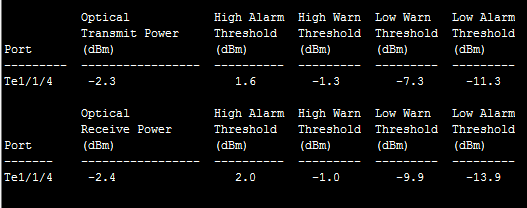How to Understand RX/TX Power Range on SFP Modules?
2023-10-23 21:11:03
The most two important factors of the SFP transceiver: Output power (TX power) and receiver sensitivity (RX sensitivity).
The optical TX power is the signal level leaving from that device, which should be within the transmitter power range.
The RX sensitivity is the incoming signal level being received from the far end device and it should fall within the receive power range.
A simple calculation is used to determine the value of the optical power (measured in dBm). The abbreviation dBm stands for decibel milliwatts. Decibel milliwatts are, as the name suggests, measured relative to milliwatts. It is a measure that's often used to determine SFP module or other device's signal strength. Some vendors may adopt milliwatt (mW) and microwatt (µW) to describe signal power, we should convert them to dBm before calculation.
Take 10GBASE-SR SFP as an example, its transmit power range is -6 dBm~-0.5 dBm, and the receiver power range is below -10 dBm. When we see an RX sensitivity around -12 dBm or lower, there is typically some sort of fault in the cable plant (bad splice, dirty connector, poorly seated jumper, etc.) that causes excessive signal loss.
When designing an optical link, one of the factors to consider is the optical power budget (maximum allowable loss). According to the TX power and RX sensitivity, we can calculate the maximum allowable loss of the SFP modules. As illustrated above, 10Gbase-SR SFP Power Budget (dBm) = TX Power (-6 dBm) - RX Sensitivity (-10 dBm)=4dBm.
The more the optical power budget, the further the fiber transceiver can support. The 10GBASE-SR SFP can support the distance of 300 m over OM3 multimode fiber patch cable and the 10GBASE LR SFP module, which enables the 10G network at lengths up to 10 km over single mode fiber patch cable.

The above picture shows it is on a healthy link if it's known to be a long outside plant run (tens of km) with a measured signal loss (using OTDR fiber test kit) that would cause such loss. In those cases, we would be using the more expensive long-haul transceivers that are more capable of sending and receiving usable signals under those more extreme situations.
Conclusion
Tx power and Rx power level of a transceiver are the main factors of transmission distance. The more the optical power budget, the better the transceiver. Before purchasing a transceiver, you’d better calculate the optical power budget according to transceiver module details.
If you want to know more, Welcome to contact Sales from
Sate Optics: Sales@sateoptics.com
Whatsapp/Wechat/Skype: +86 19520510030
Web: www.sateoptics.com
Previous:QSFP-DD vs QSFP28/QSFP56 – What Are The Differences?


